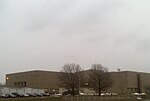New Deal Cafe
The New Deal Cafe is a restaurant, music venue and community coffee house in the historic Roosevelt Center of Greenbelt, Maryland. It is a rare example of a restaurant operated as a consumers' cooperative, as it is owned by over 200 member patrons.The cafe, which has a small beer/wine bar in the back room, features nightly and some daytime performances by regional musicians, and sponsors several outdoor music festivals each year, including the Crazy Quilt Festival and the Greenbelt Blues Festival. The cafe walls are decorated with art by local artists, which is changed bi-monthly. The arts and entertainment activities are supported by the Friends of New Deal Café Arts (FONDCA), a separate tax-exempt 501(c)(3) organization. The New Deal Cafe won WTOP's Top-10 2012 best music venue in the DC region.The cafe's menu offers breakfast, lunch, and, dinner options as well as a variety of smoothies and coffee beverages. New Deal Cafe is currently under management by the Greenbelt Consumers Co-op grocery store. There is beer on tap and a selection of wines and bottled beer. The cafe is commonly referred to by customers as "Greenbelt's community living room" or "third place", part of the third place movement. Its name comes from Franklin Delano Roosevelt's New Deal, which was responsible for the founding of Greenbelt.
Excerpt from the Wikipedia article New Deal Cafe (License: CC BY-SA 3.0, Authors).New Deal Cafe
Centerway,
Geographical coordinates (GPS) Address Nearby Places Show on map
Geographical coordinates (GPS)
| Latitude | Longitude |
|---|---|
| N 39.002811111111 ° | E -76.876530555556 ° |
Address
Centerway
20770
Maryland, United States
Open on Google Maps







